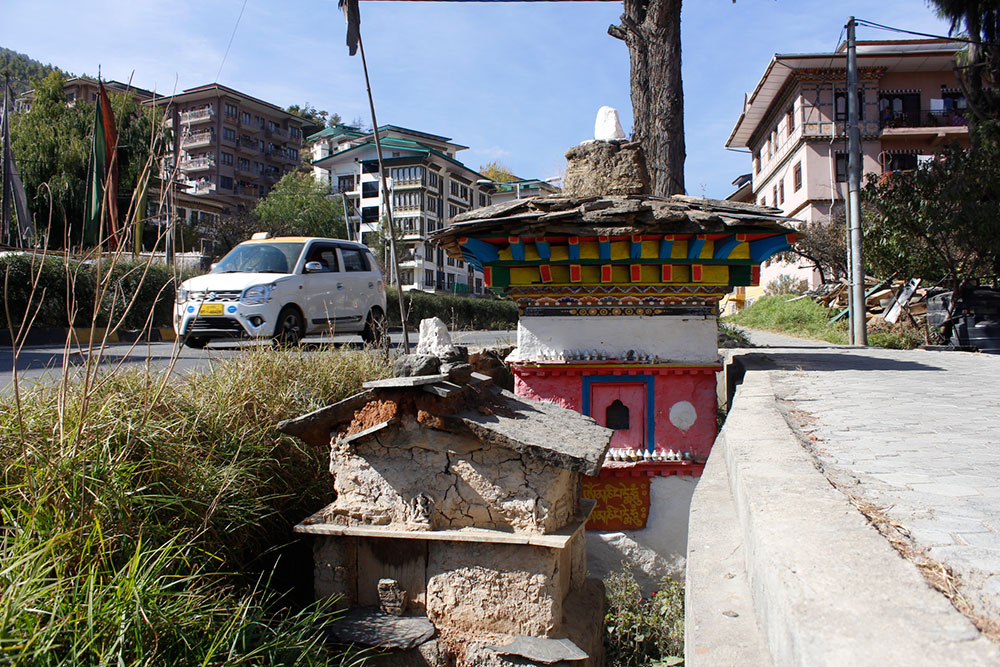Nima Wangdi
A mystical land of majestic mountains dotted with religious monuments like monasteries and choetens, fluttering prayer flags, towering dzongs overlooking lush green valleys.
This is a typical description of Bhutan, as it was a long time ago.
Looking around today, using the same description would be misleading, if not wrong, particularly in the capital city and some dzongkhags in western Bhutan.
Rapid urbanisation, unplanned development and a land selling and buying frenzy has sent the monuments to the background. What remain are the hills surrounding the city. Even the hills, once the tsamdros (grazing land) are not spared. Commercial interests hampered the protection of the traditional architecture except the two dzongs and the few monasteries in the city.
While the bigger monuments or landmarks remain, the most visible change in the landscape is the disappearing monuments forced by construction of roads and houses and the growing traffic in the capital city.
The small Namgay Khangzang Choeten at Changbangdu, on the left side of the expressway, is almost buried under the road. The roof protruding above the ground is the telltale sign of its existence.
Nidup, 60, who had been living near the choeten said people used to circumambulate the choeten in the past until the expressway was built. “It was an important landmark and it was called Changbangdu choeten. It is now forgotten and can barely be seen,” he said.
Nidup said planners wanted to remove the choeten. The choeten had been there as long as Nidup could remember. As if to teach Nidup a lesson, they raised the level of the road and buried the choeten.
Another Namgay Khangzang Choeten is trapped between the two lanes of the road above the Supreme Court in Jungzhina. The ongoing road construction has laid the road right through its foundation, leaving no space for the people to circumumbulate.
Dhantsho, 67 from Lhuntse, who was circumambulating the other choeten in the area said it is too risky with speeding cars.
Popular monuments like the Changgangkha Lhakhang are surrounded by tall concrete buildings. In the south, the first Dzong built by Zhabdrung Ngawang Namgyel is being encroached by concrete structures, including facilities for the shedra.
A small Choeten that was the landmark between Babesa and Tshalimaphel village had been demolished to give way to a road extension. “The choeten was the border of the two villages,” said a resident. “We didn’t know it was demolished until recently.”

Near it, another choeten that has been painted new is surrounded by toilets belonging to thromde workers.
Many wonder how the hills surrounding the city became private property. “It used to be tsamdro or government land as no one had ownership rights over tsamdros,” said a village elder from Chang.
Planning, not urbanization, is the problem
Responsible for cultural heritage, the Director of the Department of Culture, Nagtsho Dorji, said that planning developments should not jeopardise such monuments. “It is planning rather than urbanisation that is the problem,” she said.
The Department of Culture refused a recent request to relocate the Namgay Khanzang choeten above the Supreme Court. She said the department refused because monuments cannot simply be relocated at whim. “They were built on certain places for specific reasons and they carry their own historic value,” the director said. “Such problems arose because different agencies are working in silos.”
The choeten, if properly planned, could have reduced the ugliness of the tri-junction. Today it looks like the choeten sprouted from the four-way lane overnight.

Nagtsho Dorji said the planners should not even ask the department if they can relocate monuments that fall within their planning. This is because conserving heritage sites is not only the responsibility of the department. “Every Bhutanese is responsible for this,” she said.
There is more than urban planning disturbing cultural heritages. An official from the Department of Culture recalls an incident where people tried to relocate a Choeten from Changjiji during the construction of the present housing complex.
The choeten was spared after workers started falling sick.
Nagtsho Dorji said she comes from a conservative background but believes that change and development are necessary. “The problem, however, comes when things are not planned properly,” she said.
An urban planner from the Ministry of Works and Human Settlement said heritage sites are one of several areas that they consider while planning. But the problem is when two different agencies are involved in planning and implementation.
“We are now reviewing Thimphu’s structural plan and this should solve the problem of agencies working independently.” She said planning will have a holistic approach once the review is complete meaning all the stakeholders will work together.

Modern development has left sacred choetens fighting for space
Protecting heritage
All is not over in the capital city. Some residents or devotees are getting together to save old monuments. In south Thimphu, which was a village until a decade ago, several choetens and lhakhangs have been restored.
The famous “back to back” statue in Babesa looks better now. At Tshalimaphel, a family renovated a choeten on the road and developed it with mani (prayer) wheels. It has become a favourite place for the elderly to meet and say their prayers.
The Tshaligoenpa Lhakhang across from Babesa is being renovated by the Bhutan Nuns Foundation, which has also build some traditional structures that is contrast to the fast developing one-style concrete buildings below it.
“If it was not for the Foundation, the area would have gone to a rich businessman who would probably have planned a tourist resort,” said a Babesa resident who preferred to remain anonymous.


